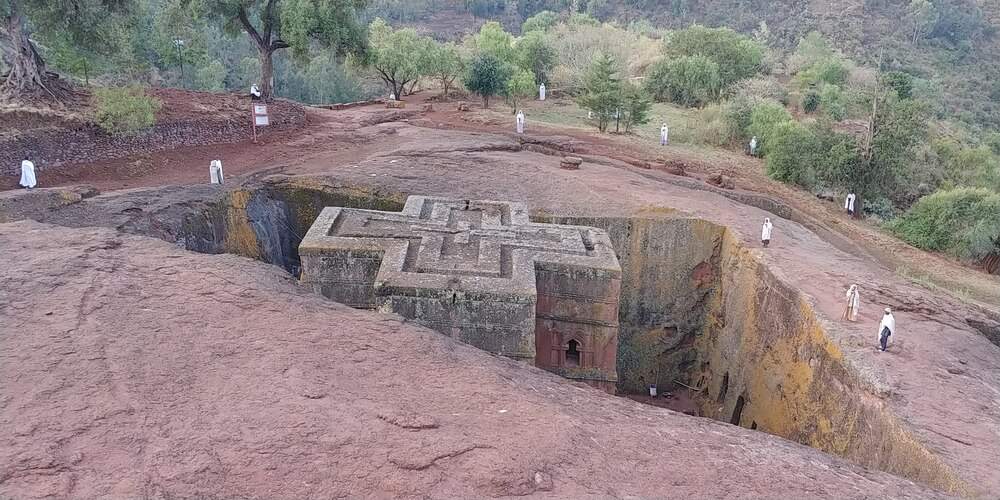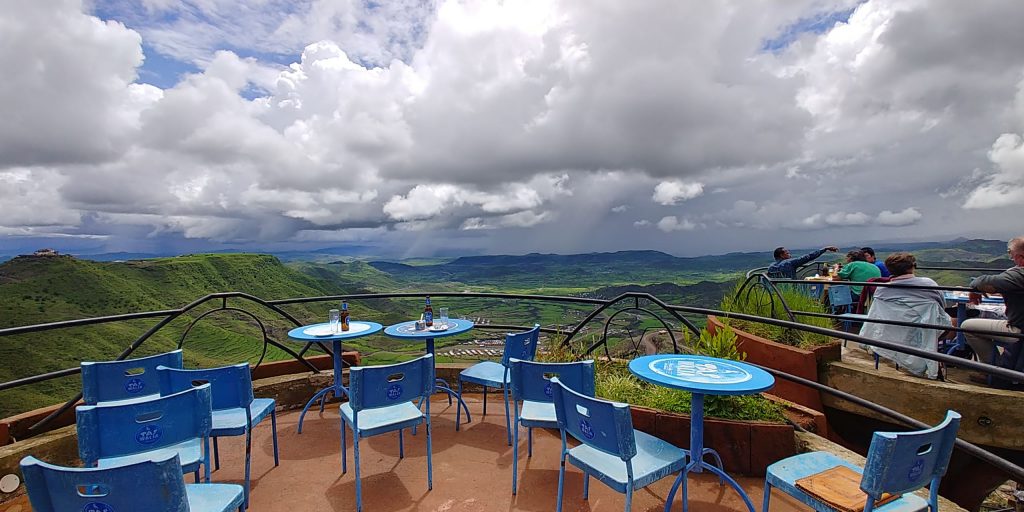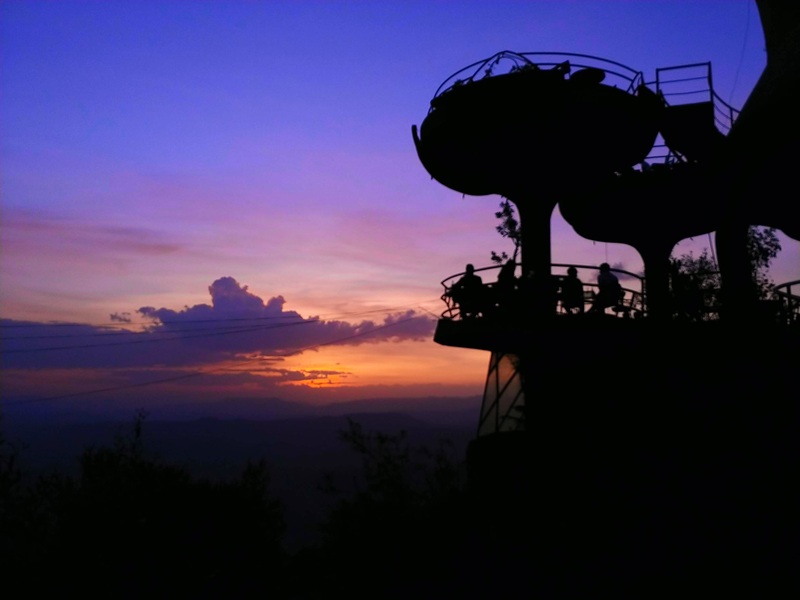Lalibela, also known as the “Second Jerusalem”, is a holy land of churches, caves, and tombs hand-hewn from red volcanic rock, in Ethiopian highlands in the 12th century.
Lalibela is Ethiopia’s holiest City, only next to Axum. UNESCO recorded Lalibela as a World Heritage site in 1978. All Eleven churches are unique and achieved by carving from the top down, without any cement or building materials. To make it even more impressive during the construction only hammers and chisels were used.
Each church has its own unique design. The most famous of these churches is the Church of St. George, which is carved in the shape of a cross and is considered the most visually stunning of all the churches.

King Lalibela built these churches to end the long and dangerous journey of Ethiopian pilgrims to Jerusalem. It took about 20 years to finish the construction of the churches.
The churches of Lalibela are not just impressive architectures; they are living entities that shape the daily lives of the local population. they hold immense spiritual and cultural significance. Every morning, the devout residents of Lalibela gather in these sacred spaces to participate in Mass and engage in prayer. The churches serve as a place of solace, where the faithful can find comfort, guidance, and strength in their daily lives.
Beyond their religious significance, the Lalibela churches also serve as a cultural heritage for Ethiopia. They are a symbol of Ethiopia’s rich history and architectural prowess. The churches have become a major tourist attraction, drawing visitors from all over the world who are captivated by their beauty and historical significance.
The First European Visitor of Lalibela
The Lalibela Churches, have become a magnet for foreign visitors who are captivated by their exceptional and unparalleled architectural designs. They have expressed their feelings in books, Magazines, and documentaries. but it is a Portuguese Priest Called Francisco Alvarez, the first European Visitor. During the 16th century, He embarked on a journey to explore these remarkable churches. As he marveled at their grandeur and intricate details, he found himself at a loss for words. He expressed his reluctance to continue describing them, fearing that his words would be met with skepticism and disbelief. In an attempt to convey the true magnificence of these structures, he solemnly said, in the name of God, that everything he had written was indeed the truth.
St. George The Best churches of Lalibela
Each church is a masterpiece of architecture, with intricate carvings, hidden passageways, and stunning frescoes adorning their walls. Narrowing down the selection to just one church is an exceedingly challenging endeavor, as each one possesses its own unique charm and beauty. However, we have to Choose the most awe-inspiring and breathtaking ones.
The Church of St. George, also known as Bete Giyorgis is our choice. This church is perhaps the most iconic of all the Lalibela Churches, with its distinctive cross-shaped design. Carved entirely out of a single piece of rock, it is a true marvel of engineering and craftsmanship. The church is surrounded by a deep trench, adding to its mystique and making it appear as if it is rising out of the ground.
What is the best Time to Visit Lalibela?
Lalibela, the most popular tourist attraction in Ethiopia, welcomes visitors throughout the year. However, to assist you in planning your trip, we have provided an overview of the best time to visit Lalibela and the recommended months to do so.
October to February is the ideal time to visit Lalibela. During this period, the sun shines all day, and the weather is pleasant, neither too hot nor too cold. This is also the peak tourist season, with churches, hotels, and other attractions attracting a large number of visitors. We recommend attending the Ethiopian Christmas celebration, which takes place on January 7 (or January 8 on leap year). This event is particularly significant as it is the also birthday of King Lalibela. The celebration is colorful and unique, with the priests singing and dancing called Beza Kullu at sunrise. As a result, accommodation can be overbooked, so we advise booking early.
From March to June, the sun is still strong, but there is a possibility of irregular small rain in march and April. Although Lalibela is busy during this time, it is not as crowded as during the high season.
From June to September, Lalibela experiences rainfall. While this may not be the best time to visit, it is ideal if you prefer fewer tourists.

How to get to Lalibela
Lalibela is situated in the northern region of Ethiopia and can be reached by car or bus, which typically takes two days. Nevertheless, the most convenient method of travel to Lalibela is by taking a 1-hour and 30-minute flight on Ethiopian Airlines. Specifically, Lalibela is served by daily flights from Addis Ababa and Axum, as well as three flights per week from Gondar. If air travel is not an option, driving by car is a reliable alternative. Buses offer the most economical means of reaching Lalibela, with daily services available from Addis Ababa, Desse, Weldia, and Bahrdar. Regrettably, the car journey is uncomfortable and requires a two-day duration.
Once you are in Lalibela there are cars arranged from hotels and Took Took, which is the best and cheapest transportation to get around.
What time the churches are Open for visitor
The churches are open to visitors Monday to Sunday
Morning Daily 8:30 AM – 12:30 AM
Afternoon Daily 1:30 PM to 5:30
The church is an important place of worship for devoted Ethiopian Christians. Sometimes there is a church service from Midnight to mid-day.
Every morning Mass is held in the churches. during the mass service tourists may arrange a visit with a tour guide to Attend and see the service. The advantage is that you can see the best atmosphere of ancient Christian culture with colorful clothes and large processions.
The church in Lalibela is considered a sacred place, so dress appropriately. This means that the body and head must be covered with a scarf. Women especially need to dress conservatively and avoid wearing shorts, otherwise, you may be prohibited from entering.
Entrances to Lalibela Churches
To enter the churches, it is necessary to pay an entrance fee and obtain a receipt. The cost of admission to the churches is 100 USD and is valid for a duration of four days. It is imperative to safeguard the ticket as it may be requested at the entrance of the churches visited. The ticket office is conveniently located adjacent to the Bete Medhanialem gate.
Other Things to Do and Activities in Lalibela
Most visitors visit Lalibela churches as part of a one or two-day trip and that’s a pity as there are many things to do around Lalibela to keep visitors occupied for at least a few more days. This list of things to do in Lalibela, will make you realize that there is more to do, take a look at these activities.
Sunset at Ben Abeba Restaurant,
Located in the stunning highlands, Ben Abeba Restaurant is a must-visit Restaurant for anyone looking to enjoy a breathtaking sunset experience while indulging in Dinner and drinks. The restaurant’s unique architecture, which resembles a giant Flower, offers a panoramic view of the surrounding landscape, making it the perfect spot to watch the sun go down.
Make a reservation to get a good seat and bring a good Jaket as night could be windy and cold.
Day Trip to Yimrehane Kirstos Monastery
Have you been acquainted with the Yimrehane Kirstos Monastery? This renowned site is a prominent feature of Lalibela. Situated approximately 45 kilometers north of Lalibela Town, the monastery holds historical significance as it dates back to the 12th century and was constructed by King and Saint Yimrehane Kristos prior to the era of Lalibela. Embarking on a day trip to Yimrehane Kristos Monastery is a truly humbling experience, as it allows one to discover the rich history of cave churches, enjoy the surrounding valleys and local farmers’ lives. This excursion serves as a valuable addition to any Lalibela travel itinerary.
Trek to Asheton Maryam Church Monastery
Ashton Maryam is a mountain that dominates east of Lalibela. On Top of the mountain, a beautiful church is cut out of the surrounding rock.
Depending on your fitness level and how active you wish to be there are a number of different options for you to enjoy.
A popular choice is to take a 1.5-hour hike up the mountain and enjoy the offer spectacular views of Lalibela from the Top and then again Back to Lalibela. Or Drive all the way to the mountain and walk a short distance. Travelers also can choose to ride a Mule to get up to the top of the mountain.
Abune Yosef Mountain Trekking
Travelers make up to 4 days of trekking from Lalibela to Abune Yosef in pursuit of Nature. Experience the way of life of the Highlander farmers, take part in their daily activities, and enjoy the stunning Mountain. On Abune Yosef Mountain there is conservation work to protect the natural habitat and wildlife of the area. The area is home to endemic animals like the Ethiopian Wolf, Gelada Baboon, and birds.
Where to eat In Lalibela – Restaurants
From traditional Ethiopian cuisine to international dishes, visitors can find a variety of options to suit their taste buds. There are few restaurants in Lalibela that offer vegetarian and vegan options, as well as gluten-free choices. In addition to the food, visitors can also enjoy the warm hospitality of the locals and experience the unique cultural atmosphere of Lalibela. here we list three restaurants in Lalibela.
Ben Abeba Restaurant
The Ben Abeba Restaurant, situated to the west of Lalibela’s cliff edge, is widely regarded as the city’s premier dining establishment. It is owned and operated by a duo of Ethiopian-Irish descent. The restaurant’s futuristic design is a sight to behold, and guests are treated to breathtaking views of the surrounding mountains and a picturesque sunset (recommended arrival time of 5:30 PM). This is an ideal opportunity to unwind and enjoy a cold beer while observing the sun’s descent behind the mountains and the valley below Lalibela.

Kana restaurant
Located south of the Lalibela churches, the Kana restaurant opened very recently. This restaurant is the only true dining experience in Lalibela.
Open all day to enjoy a variety of Ethiopian and European dishes. The essence of Ethiopia is present in every detail, of the restaurant from the beautiful handmade wooden furniture to the unique decoration of bamboo ceilings, recreating the atmosphere of an exclusive Ethiopian charming style. It is, without a doubt, the perfect place to take a break after a long day touring the church.
Seven Olive Hotel Restaurant.
The Seven Olive Hotel Restaurant provides a range of dining options, including breakfast, lunch, and dinner, as well as traditional Ethiopian cuisine and beverages. It is conveniently located in close proximity to the first group of churches, making it an ideal lunch destination. The restaurant’s verdant surroundings offer a refreshing atmosphere, making it a popular choice for tour groups and families seeking a quick coffee or meal. Notably, the Beyaynetu, a nutritious Ethiopian fasting dish comprising vegetables and stews, is a standout dish.
